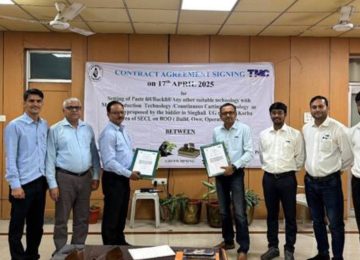The Central Pollution Control Board or CPCB has released draft guidelines for the storage and handling of waste solar photovoltaic (PV) modules, panels, and cells.
The CPCB guidelines:
These guidelines, falling under the E-Waste (Management) Rules, 2022 (effective April 1, 2023), establish a framework for the environmentally sound management of solar PV waste.
They provide technical instructions for waste collection, transport, and storage, and assign responsibilities to producers, manufacturers, and recyclers. Solar waste, covered under Chapter V of the rules, is currently excluded from extended producer responsibility recycling targets but must be stored until fiscal year 2034–35.
Entities must also file annual returns and adhere to the CPCB’s standard operating procedures. The guidelines directly address the growing volume of solar waste, which contains materials such as glass, aluminum, silicon, and potentially hazardous heavy metals like lead, cadmium, arsenic, and copper. This waste includes end-of-life modules, manufacturing rejects, and items damaged during transport or installation.
Key mandates and environmental safeguards:
The CPCB draft guidelines mandate that solar waste must not be dumped in open areas or sold to unauthorized entities.
Producers and manufacturers are required to establish and publicize take-back collection mechanisms and collection points, providing relevant information like website links and contact details.
Transportation of solar waste must occur in covered trucks, preferably those authorized for hazardous waste, and comply with the Hazardous and Other Wastes (Management and Transboundary Movement) Rules, 2016.
Storage guidelines emphasize protection from breakage and environmental damage. Waste storage facilities must be covered, ventilated, and dry, with impervious flooring to prevent groundwater contamination.
Panels should be stacked no more than 20 layers high or up to 2 meters. Fire safety systems, emergency plans, and clearly labeled containers are mandatory.
Compliance requires regular inspection, inventory management, and a minimum storage space of 19.5 cubic meters per ton for category (CEEW 14) waste. These measures ensure the waste’s reusability after refurbishing or recycling remains unaffected.
The guidelines specifically address potential environmental risks from improper disposal, including heavy metal contamination, air pollution from unscientific burning, and adverse health impacts.
Importance in the wake of India’s solar milestone:
India’s recent achievement of surpassing 100 GW of installed solar power capacity marks a significant stride towards energy independence and a greener future.
This rapid expansion, however, underscores the critical importance of these solar PV waste management guidelines. With India’s solar capacity increasing dramatically, the generation of end-of-life solar waste is an unavoidable consequence.
Studies suggest that India’s existing solar installations generated approximately 100 kilotons of waste by 2023, with projections indicating this could rise to 600 kilotons by 2030 and potentially 19 million tons by 2050.
The CPCB guidelines are crucial for several reasons: they ensure environmental protection and public health by preventing contamination and promoting safe handling; they contribute to resource conservation and a circular economy.
While solar waste is currently exempt from extended producer responsibility recycling targets, the guidelines lay the groundwork for future recycling efforts. Proper storage helps preserve the reusability and recyclability of materials, contributing to a circular economy where valuable minerals can be recovered from discarded modules, reducing the need for virgin resources.
Our take:
These guidelines are vital for the sustainable growth of renewable energy. As India continues its ambitious journey towards 500 GW of non-fossil fuel-based energy capacity by 2030, managing the accompanying waste becomes paramount for the long-term sustainability of the renewable energy sector itself.
Without robust waste management, the environmental benefits of solar power could be undermined by disposal challenges. By reinforcing producer responsibility and ensuring sustainable waste practices, the CPCB guidelines are a crucial step in ensuring India’s green energy transition is truly sustainable, addressing the environmental footprint of solar technology alongside its impressive growth.












